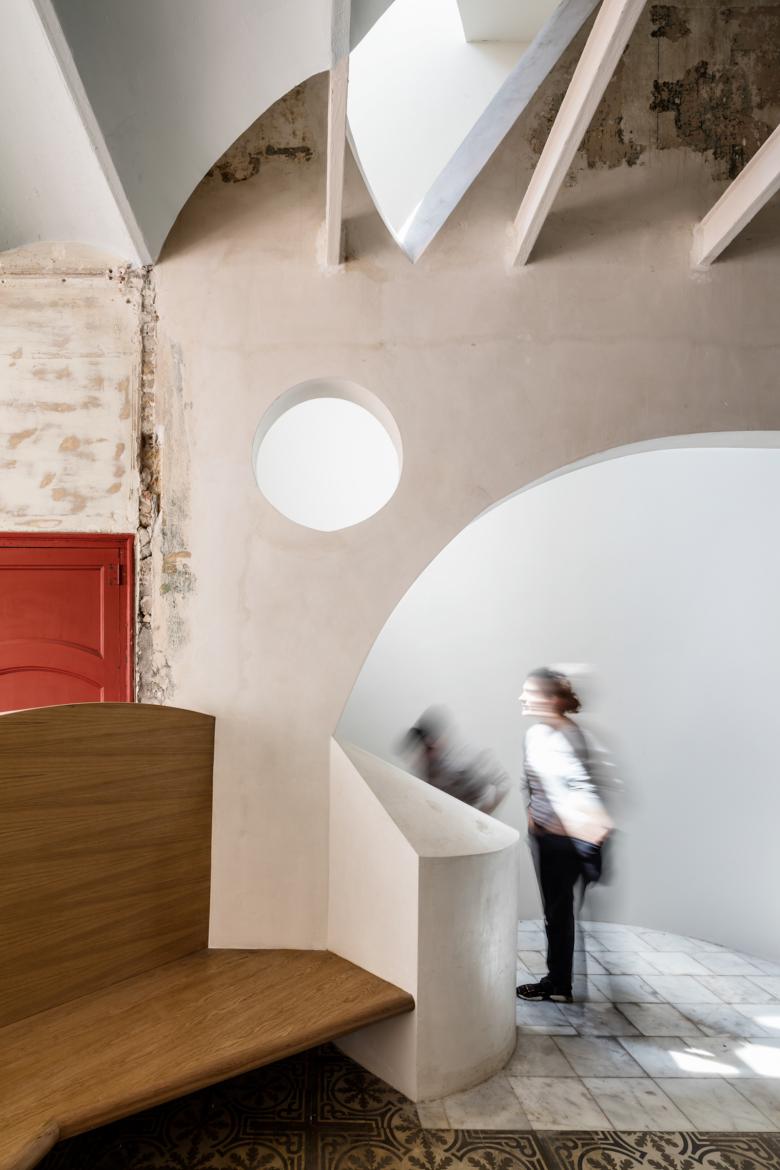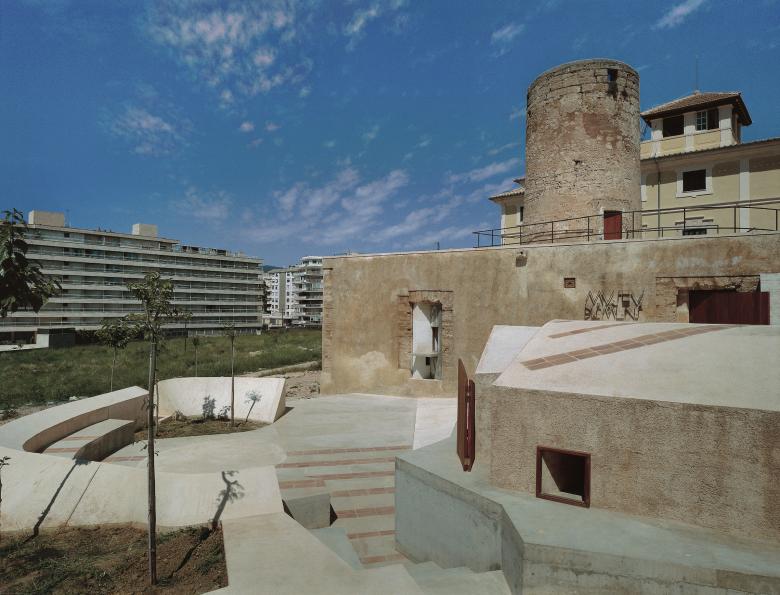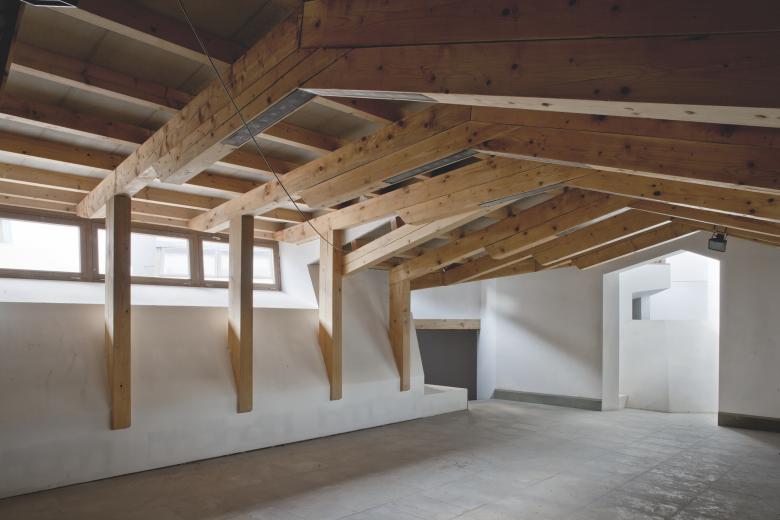Interview with Eva Prats and Ricardo Flores
'For us, preservation means being contemporary'
Vladimir Belogolovsky
19. September 2023
Sala Beckett, Barcelona, 2016 (Photo: Adrià Goula)
In Vladimir Belogolovsky’s interview with Eva Prats and Ricardo Flores, the founders of Barcelona-based Prats & Flores Arquitectes, the couple talked about treating the apartment where they run their practice as a pedagogical tool, learning by drawing over and over again, adapting and reusing their old ideas, being seduced by Frank Gehry’s house in Santa Monica, completing their PhDs after many years of practice, and living in an apartment designed by another architect — and liking it.
Eva Prats was born in 1965 in Barcelona. She graduated from the Barcelona School of Architecture (ETSAB) in 1992 and worked at the office of Enric Miralles for nine years. She left in 1994 to start a studio with a friend after they won the EUROPAN III International Housing Competition. (The project was later built.) Ricardo Flores was born in Buenos Aires, also in 1965. He graduated from the Faculty of Architecture at the University of Buenos Aires (FADU-UBA) in 1992 and then did his Master in Urban Design at ETSAB in 1993-94, graduating in 1996. He worked with Miralles for five years, overlapping with Eva for one year while studying at ETSAB. Ricardo joined Eva’s practice in 1998 when they launched their joint practice. By then they were a couple for three years. After many years of practice, both architects completed their PhDs — he at ETSAB in 2016 and she at RMIT in 2019.
Flores & Prats are known for their seductively beautiful adaptive-reuse buildings that evolve in ways that are surprising and comforting in how the architects choose to negotiate between the past and the present. This interplay is not obvious and requires a careful examination, as the result is thoroughly synthesized and full of moments that are alluring, even strikingly joyful. Among the architects’ most acclaimed projects are Mills Museum (Palma de Mallorca, 2002), Casal Balaguer Cultural Centre (Palma de Mallorca, 2016), and Sala Beckett (Barcelona, 2016). About the latter, the architects told me, “It is one project where most of our ideas can be found.”
Mills Museum, Palma de Mallorca, 2002 (Photo: Duccio Malagamba)
Vladimir Belogolovsky (VB): I read that you work out of a sprawling beautiful apartment full of memories that you preserve and where you excavate and test your ideas. Could you tell me more about your studio space?
Eva Prats (EP): This apartment makes us aware of preindustrial construction techniques from the late 19th century. There are old doors and tiles that are very delicate, beautiful, and inspirational. There is a gorgeous staircase with Catalan vaults with overlapping arches, similar to the ones that Guastavino built in New York but on a much smaller scale, of course. This stair is really striking. I remember when I just started working here, I was so afraid of going up. I was trying to walk very carefully and close to the walls. [Laughs.] The whole structure looks so impossibly thin! I couldn’t understand how it all worked. There is a lot of culture and ingenuity embedded in such structures. For sure, our building has an influence on us, and our eyes are used now to many beautiful techniques and sensibilities that we come across here all the time. Unlike other architects who like to take things out and replace them with their own, we enjoy observing what this apartment is offering us.
Ricardo Flores (RF): Our eyes are constantly getting used to how things age and we learn how not to interfere with this process, which in itself is so beautiful. The accumulation of history and different traces is an asset for us and we try to preserve as much as possible. In this apartment, most rooms have changed users and functions, but many traces remain. We still call some of the rooms by the names of the former occupants and there are features that remind us of their presence. We gladly accept what we inherit. And projects like Sala Beckett benefited from what we learned and tested right here first. The apartment is somewhat pedagogical for us: it points us in certain directions that have become our overarching strategy, first unconsciously and now quite purposefully. If we know that old doors can be beautiful, why throw them away and replace them with something that has no character? We constantly ask how we are treating our heritage. We can’t keep on demolishing buildings. We should treasure our memories.
The atelier of Ricardo Flores and Eva Prats on Carrer de Trafalgar in Barcelona (Photo: John Hill/World-Architects)
VB: You wrote an essay, “Drawing Without Erasing.” Is it about your design methods?
EP: It was recently published in book form. It is about our design process: drawing, adding another layer of tracing paper over it, fixing it with tape, and drawing again. Then another layer, another drawing, and so on. Even when we work with computer prints, we draw the same way by hand over them. This method helps us to redraw and propose different geometry on top of the old one. This is how we work and this is how Enric, who influenced both of us a lot, used to work. We keep all the layers because we can go back to see how the whole process has accumulated. We work the same way with our models. They are made of numerous elements that can be taken apart.
RF: Not erasing drawings allows us to keep a record of our thoughts, doubts, crises, and all kinds of moves and steps, and to be able to trace back our ideas and decisions. We don’t want to lose the memories of how the various stages of projects were achieved. Our own archive is one of the fundamentals of our studio. We accumulate our memories and we try to use them again. Adaptive reuse is not only the way our projects are built, this is how they are designed and conceived. We constantly revisit our tubes with old drawings to see if our old ideas can be adapted and reused.
EP: I think it is important for our discipline. Even from the time when I was a student, I remember erasing something too much and, suddenly, I would lose my train of thought. In a way, we rely on our drawings.
RF: It is also a good way to keep material for self-critique through analysis and to move forward. A pencil is a tool for critique. When you leave the process at sight others can enter a conversation as participants. If you look at the sketches of Louis Kahn, for example, you can see not only solutions but how they were achieved and through how many iterations. If you only see the final clean drawing, you do not know how he arrived at this final solution. Reading process drawings tells a full story and welcomes participation and better understanding.
EP: Our solutions never appear from the start. You really need to push to achieve them.
VB: You have said, “The slow time of hand drawing makes our thinking and our various interests visible,” and elsewhere, “We use drawing as a tool for observing and recording time, the drawing taught us to superimpose different periods in the same document, making them live together.” This fusion of times and the idea of bringing them into our own time is quite remarkable.
EP: We enjoy it. First, you draw what’s there, and, suddenly, you bring a new program and things start to come up and merge. It is a kind of negotiation between the past and the present. So, old and new are working together to produce something else, which contains the memories of both past and new uses.
VB: Do you ever bring memories and traces of your old projects into the new ones?
EP: Sure, as much as we would like to develop new ideas into each project, we, of course, bring our memories and traces of what we have done before.
RF: It is inevitable because we always bring our own personalities into all of our projects. For example, for us Sala Beckett is a synthesis of many years of research, as well as some of our key projects built before.
Sala Beckett, Barcelona, 2016 (Drawing: Flores & Prats)
VB: Is Sala Beckett your most exemplary project to date? Could you share any lessons from it?
EP: It is one project where most of our ideas can be found. Interestingly, when we had just started working on this project there were many reviews and discussions, and one of the critics, an older architect, told us, “You have no confidence in contemporary architecture.” [Laughs.]
RF: But for us, preservation means being contemporary. This idea is now becoming quite accepted by younger architects. Adaptive reuse is not only our focus nowadays, but 15 to 20 years ago working on a renovation was considered a second-class project. Very few architects were willing to do it. If you were not doing something new you were not treated as a “real” architect.
EP: But we found this type of work very rich. We never understood why architects could not see the potential in renovations. We were very happy working on them from the very beginning.
VB: Well, you started your practice in 1998, just one year after Frank Gehry completed his Guggenheim Bilbao, which seduced the entire profession, as well as municipalities, university administrations, and corporate and museum boards all over the world. Suddenly, everyone wanted a new, shiny signature thing to make their city proud.
EP: We liked it as well. But at the exact time it opened we visited Los Angeles and saw his house in Santa Monica, which is an adaptive reuse project. It seduced us even more than Bilbao. We really liked it, not to the point that we would do something similar, but we enjoyed it.
RF: We can imagine that everyone in Santa Monica was mad, but we loved it.
VB: Did you have a chance to go inside?
EP: No! There was a sign that the place was alarmed and that entry was strictly prohibited.
RF: We observed the house very carefully and we went to see many of Gehry’s early projects, from when he used very rudimentary materials such as plywood, corrugated metal, and chain-link fencing. It was surprising but not an influence on us. We liked the energy, passion, and originality. It is a beautiful thing with its own logic. It was a joy to see it and we could tell the architect enjoyed designing and building it.
EP: We liked the way he collapsed different geometries. The house reminded us a bit of Miralles. There is a similar idea of the juxtaposition of materials, even if the articulation is different. There is this fascination and joy of layering and accumulation that is similar in the work of the two architects. Just by looking at it, we could see the real joy of making it. Even though we were not able to go inside there are so many clues on the outside. The place is very extraverted, as the Miralles projects are. The house is very charismatic, which is probably a reflection of the Gehry’s character.
Casal Balaguer Cultural Centre, Palma de Mallorca, 2016 (Photo: Adrià Goula)
VB: You both did your PhDs after many years of practice. Why did you feel you needed to go back to school? What did you learn from that experience?
EP: It was Miralles who kept telling me that I needed to get my PhD. He would say, “You have to be at school.” And I would respond, “But I just finished.” He kept insisting. I agree that school is such a wonderful place for exchange, but when I finished my studies, I really wanted to work. I did start my PhD program right away, but I wasn’t able to follow through. I finished all the courses but could not devote time to my thesis. Then years later I was invited by the RMIT in Melbourne to do a “PhD by practice,” which was started by Professor Leon van Schaik. That program had meetings every six months in Europe. For me, it became an opportunity to reflect on our work on adaptive reuse. Before that time, we learned things by practice; now I can think about our work more clearly. It was important to understand that it wasn’t just a relationship between the building and the architect but that there was also a client, and that was quite an important part of the design as well. So, there are three poles. And in this relationship, the building is important too because it has a character and we can’t damage that. The building has a voice and a physical presence. So, every decision, in a way, needs to be approved by all three partners of this relationship. If not, we can’t move ahead. Our presentations were made for the panels that the school provides and you didn’t know in advance who was coming.
RF: I also finished my PhD about 14 years after I started. And in my case, it was also Enric who pushed me to complete it. One of the reasons for this is that here in Spain you need to have a PhD in order to teach, which we always wanted to do. And having our practice would delay our decisions to finally commit to working on our thesis. It was so painful for us but it was fascinating to finish it. My PhD focused on Casa La Ricarda designed by Antonio Bonet through a process of over 15 years, mostly through correspondence, which was diligently collected by the owner of the house and is archived here in Barcelona. The house was built on the outskirts of Barcelona in 1963 while the architect lived in Buenos Aires, my hometown, where he emigrated during the Spanish Civil War. It was a beautiful process to study, which meant drawing the house again and again. So, the final thesis was a series of drawings and a detailed model.
What I learned by going through this process was to rationalize a whole approach toward design through drawing, which is exactly how we do it in our office and teach our students. The point is to discover your own fascination with the places you like through the act of drawing, again and again. Drawing is a way of thinking, a tool to observe and understand spaces. There were no plans for the Bonet house left, so I had to do my own drawings through visits. I also learned a lot from his relationship with the client, which was about producing this masterpiece of a house — on par with some of the best houses by Richard Neutra, Rudolph Schindler, or the Case Study Houses, all in LA — and maintaining a good friendship at the same time. I learned a lot from this experience when we had our own long-distance projects in Mallorca and Milan.
VB: What about your own place? Do you live in a house that you designed?
RF: We live in an apartment building that was built in 1937. It is a very beautiful building, actually, one of the most elegant ones in Barcelona. It is a modern building with curved geometry incorporated into it. The building has a very generous entry with steel and glass doors and facades and a gracious garage entry. And there is an elegant circular stair with expansive glazing.
EP: We did not touch much our apartment because we like it the way it is. There are very minor interventions. We wanted to preserve the quality of eastern light and original tile work, all of which is quite good and we did not want to alter anything. We were afraid to spoil it. [Laughs.]
Eva Prats and Ricardo Flores
Related articles
-
Building Bridges with Chris Luebkeman
1 day ago
-
Architecture as an Offering
1 month ago
-
Building a Better World, from the Inside Out
on 1/25/24
-
Engaging with Reinier de Graaf's Reality
on 12/5/23
-
‘Our cities can reflect a living ecosystem’
on 11/21/23





